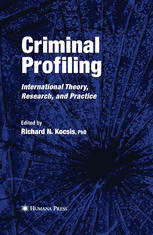
Criminal Profiling: International Theory, Research, and Practice PDF
Preview Criminal Profiling: International Theory, Research, and Practice
Criminal Profiling riminal rofiling C P International Theory, Research, and Practice Edited by Richard N. Kocsis, PhD Forensic Psychologist ©2007HumanaPressInc. 999RiverviewDrive,Suite208 Totowa,NewJersey07512 www.humanapress.com Allrightsreserved.Nopartofthisbookmaybereproduced,storedinaretrievalsystem,ortransmittedinanyformorby anymeans,electronic,mechanical,photocopying,microfilming,recording,orotherwisewithoutwrittenpermissionfrom thePublisher. Thecontentandopinionsexpressedinthisbookarethesoleworkoftheauthorsandeditors,whohavewarranteddue diligenceinthecreationandissuanceoftheirwork.Thepublisher,editors,andauthorsarenotresponsibleforerrorsor omissionsorforanyconsequencesarisingfromtheinformationoropinionspresentedinthisbookandmakenowarranty, expressorimplied,withrespecttoitscontents. Thispublicationisprintedonacid-freepaper.(cid:2)(cid:3) ANSIZ39.48-1984(AmericanStandardsInstitute)PermanenceofPaperforPrintedLibraryMaterials. ProductionEditor:AmyThau CoverdesignbyKarenSchulz Foradditionalcopies,pricingforbulkpurchases,and/orinformationaboutotherHumanatitles,contactHumanaattheabove addressoratanyofthefollowingnumbers:Tel.:973-256-1699;Fax:973-256-8341;E-mail:[email protected],or visitourWebsite:www.humanapress.com PhotocopyAuthorizationPolicy: Authorizationtophotocopyitemsforinternalorpersonaluse,ortheinternalorpersonaluseofspecificclients,isgranted byHumanaPressInc.,providedthatabasefeeofUS$30perpage,ispaiddirectlytotheCopyrightClearanceCenterat 222RosewoodDrive,Danvers,MA01923.Forthoseorganizationsthathavebeengrantedaphotocopylicensefromthe CCC,aseparatesystemofpaymenthasbeenarrangedandisacceptabletoHumanaPressInc.Thefeecodeforusersof theTransactionalReportingServiceis:[978-1-58829-684-9/07$30]. PrintedintheUnitedStatesofAmerica.10987654321 eISBN978-1-60327-146-2 LibraryofCongressControlNumber:2007927140 Dedication Ezt a konyvet neked irtam Anyukam szereto fiad Rihard. v About the Editor Richard N. Kocsis, PhD, is a forensic psychologist in private practice. He is the author/co-author of close to 90 scholarly publications (articles, book chapters, etc.) on the topics of criminal profiling, serial violent offenders, and their criminal investigation. He has served as an expert consultant to law enforcement,emergency,andprosecutionagenciesaswellasprivatelawfirms. In addition to his clinical and forensic work, he has held various academic positionsintheareasofforensicpsychologyandcriminologyincludingLecturer inInvestigations(Policing).In2000,hewasawardedtheAustralianMuseum’s prestigious Eureka prize for critical thinking in recognition of his scientific research in the area of criminal profiling. vii Preface International Perspectives into the Practice and Research of Criminal Profiling Today criminal profiling is no longer viewed as some secretive, mysterious technique that police from the United States of America exclu- sively indulge in when seeking to solve high-profile aberrant forms of crime. Althoughpopularculturerepresentationsofcriminalprofilingstillmostlyfavor such depictions by emphasizing this context, the reality is that individuals from a range of occupational and disciplinary backgrounds from around the world are involved in the practice loosely referred to as “criminal profiling.” Different nomenclature is adopted from time to time to describe essentially the same practice such as “offender profiling,” “psychological profiling,” “person- alityprofiling,”and“crimeanalysis,”andindeeddifferenttechniquesareoften employed,butnonethelessasanendeavorprofilinghasexpandedbothinappli- cation and in popularity across the world. Criminal profiling has evolved chiefly because researchers and commen- tatorsfromaroundtheglobehavespentmanyyearsexaminingtheperpetrators of serious crimes such as murder, rape, and arson. In particular, they have concentrated their efforts on studying the motivations and actions of violent offenders while seeking to document the experiences of both the victims and the perpetrators of crime. Many have also sought to assess the input of inves- tigative experience employed in criminal investigations and the influence of expert witnesses on jury decisions and examined at length the assessment and treatment of the protagonists of crime. Although many practitioners such as criminologists, sociologists, psychologists, psychiatrists, and police have devoted much of their time to examining these important issues, many have donesowithinthecontextofcriminalprofilingandhowsuchstudiescanbetter inform the practice of profiling. Criminal profiling at its core is concerned with understanding crime from the perspective of both the perpetrator and the victim. Specifically, it is concerned with identifying, that is, predicting who is most likely to offend in ix x Preface given ways and who may be most at risk in terms of being a victim of crime. Societiesallaroundtheworldhavehistoricallybeeninterestedinunderstanding andexplainingthephenomenonofcrimeanditsmyriadofmanifestationswhich is why perhaps the profiling of all manner of crimes has gathered so much interest around the world and continues to occupy our collective fascination. Thisbookhassoughttofocusthisinterestincriminalprofilingbybringing together some of the more interesting analyses undertaken in countries such as the United Kingdom, the Netherlands, Finland, France, Belgium, Canada, Italy, Switzerland, Australia, and of course the United States of America by drawing together the work of international authors in the field of criminal profiling. Put simply, the aim of this book is to highlight differing perspectives and challenges in profiling by discussing work that has been undertaken to date and identifying the research that remains to be done if criminal profiling is to be developed into a robust, scientific endeavor. This book is not confined to examining simply the various applications of profiling and discussing the various techniques it employs but endeavors to explore the legal and policy dimensions concerning its admissibility in various criminal jurisdictions and thetheoreticalassumptionsunderpinningitspractice.Thebroaderintentofthis book is to encourage continued interest in criminal profiling with the view to promoting its further development to the point where it can be used in a reliable,responsiblemanner.Ultimately,itishopedthatcriminalprofilingwill assist in improving our comprehension of crime in its many and varied forms and help societies the world over to prevent and combat crime in the future. Richard N. Kocsis, PhD Contents Preface ............................................................ ix Notes on Contributors............................................... xv Part I Profiling Crimes of Violence CHAPTER 1 Homicidal Syndromes: A Clinical Psychiatric Perspective George B. Palermo.............................................. 3 CHAPTER 2 Offender Profiles and Crime Scene Patterns in Belgian Sexual Murders Fanny Gerard, Christian Mormont, and Richard N. Kocsis........ 27 CHAPTER 3 Profiling Sexual Fantasy: Fantasy in Sexual Offending and the Implications for Criminal Profiling Dion Gee and Aleksandra Belofastov............................. 49 CHAPTER 4 Murder by Manual and Ligature Strangulation: Profiling Crime Scene Behaviors and Offender Characteristics Helinä Häkkänen............................................... 73 CHAPTER 5 Criminal Propensity and Criminal Opportunity: An Investigation of Crime Scene Behaviors of Sexual Aggressors of Women Eric Beauregard, Patrick Lussier, and Jean Proulx............... 89 xi xii Contents Part II New Techniques and Applications CHAPTER 6 Case Linkage: Identifying Crimes Committed by the Same Offender Jessica Woodhams, Ray Bull, and Clive R. Hollin ................ 117 CHAPTER 7 Predicting Offender Profiles From Offense and Victim Characteristics David P. Farrington and Sandra Lambert........................ 135 CHAPTER 8 Criminal Profiling in a Terrorism Context Geoff Dean..................................................... 169 CHAPTER 9 Geographic Profiling of Terrorist Attacks Craig Bennell and Shevaun Corey............................... 189 Part III Legal and Policy Considerations for Criminal Profiling CHAPTER 10 Criminal Profiling as Expert Evidence?: An International Case Law Perspective Caroline B. Meyer.............................................. 207 CHAPTER 11 Criminal Profiling: Impact on Mock Juror Decision Making and Implications for Admissibility Anne Marie R. Paclebar, Bryan Myers, and Jocelyn Brineman.... 249 CHAPTER 12 The Phenomenon of Serial Murder and the Judicial Admission of Criminal Profiling in Italy Angelo Zappalà and Dario Bosco................................ 263
